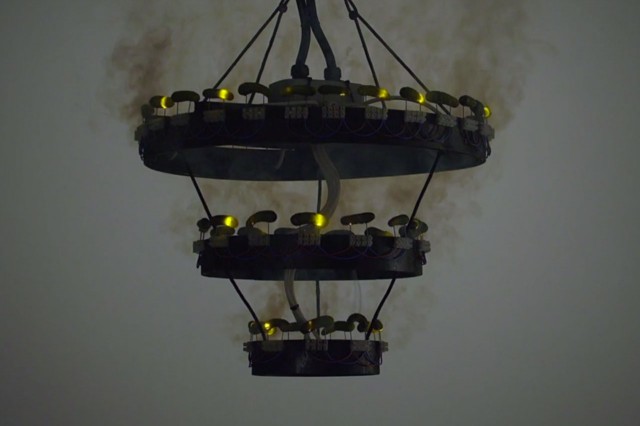
"We knew the time had come to create something wondrous with pickles," Sam Bompas, one half of gin-cloud generating, wedding cake-exploding culinary masters Bompas & Parr, tells Wired.co.uk. The pickle has been overlooked for too long.
Bompas is relaying the story of how the Gherkin Chandelier—a gherkin-powered piece of lighting with an eerie glow akin to the Grinch lit up at Christmas—came to be.
"Thinking about the development still gives me goosebumps. Risking death to explore an everyday sultan of savor!"
You might not associate gherkins with imminent death, but it takes rather a lot of energy to light up one gherkin, let alone a rather striking chandelier filled with them.
After running voltage through one gherkin and beholding the wonder before them, Bompas & Parr called in an electrician to verify exactly how much power would be needed to charge up a whole chandelier. He told the team a smallish pickle draws in 300W, while a large gherkin would need 500W. "He helped us with the electrical schematics but did it entirely off record. He was worried that the project was so dangerous that his insurers would balk if they got wind of it."
From the look of the video the team created for Nowness, with help from Gourmand, he was right to worry.
The gherkins fizzle, steam, and spark, before the word "Death" pops up on screen—the chandelier draws the equivalent energy of two electric chairs, the video tells us. "It's a savage comparison and one which gives everyone a feel for the sheer power we are running through the gherkin chandelier," says Bompas of the comparison.
Gherkins glow when electricity is passed through them because of their high acetic acid and sodium chloride content (sodium vapour gives off a yellow light and can be found in street lamps).
"We knew you could use any pickled foods, even hotdogs, for improvised food-based light features. But gherkins are best through their high water content and translucence, the ultimate food based bulbs!" says Bompas. "The prince of pickles works as a high resistance material, like the filament in a bulb with a ghostly yellow light. The electricity excites the sodium ions in the salt. Falling back to ground state they emit light at a frequency called Sodium D-line. This light frequency has allowed space scientists to identify sodium in Mercury's atmosphere."
The idea of turning the humble gherkin into something more, to showcase these incredible properties, had been "percolating" in the Bompas & Parr consciousness for some time, said Bompas.
They wired the gherkins together in parallel to increase the output and stability of the charge. Bompas describes the first incarnations as "like something out of a Heath Robinson illustration—but more dangerous!"
It took about a week to solder and wire the final creation together, and it's a sight to behold—albeit for just one use. Bompas warns, if you're making your own version don't let it run for too long, else you will "totally cremate the pickles."
"Also be advised that you might fuse your mains, and there's a danger of death. But the results will be worth it. Nothing beats the taste sensation when gherkins collide with electricity." So, unless you're a really, really big gherkin fan, it might be best to avoid this one. (Wired.co.uk is particularly fond of the vinegary treats, but will be leaving this one to the experts, donned in fireproof suits.)
Like much of the team's work, it's quite a sensory spectacle. But what's the ultimate goal of building a one-time only pickle light fixture?
"We're keen on giving people a 'naked lunch' and looking again at what's on the end of their fork. Hopefully projects like this will help folk reflect on the huge biological, social, cultural, architectural, physiological, and experiential implication of even the most simple dishes.
"There's magnificence in even the mundane pickle. All foods can be enchanted if you address them creatively. There's joy and wonder in the most humble foods."
reader comments
37